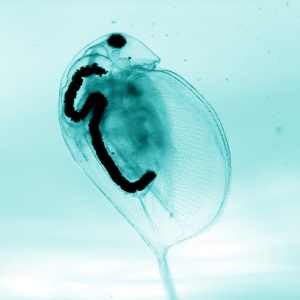Jul 2 2009
Clemson scientist Stephen Klaine has been awarded two $400,000 EPA grants to study a subject that did not exist a decade ago. Klaine is part of the young field of nano-ecotoxicology: the investigation of the impact that nanoparticles have on the environment.
 A Clemson scientist is studying how carbon nanotubes affect the tiny water flea, or daphnia
A Clemson scientist is studying how carbon nanotubes affect the tiny water flea, or daphnia
Klaine is interim director of the Clemson Institute of Environmental Toxicology. An aquatic toxicologist, Klaine's research has focused on interactions between manufactured materials and the environment, particularly how man-made chemicals affect water and organisms in rivers and streams. His most recent work has investigated the toxicological effects of pharmaceuticals in Lake Conestee and the Reedy River in Upstate South Carolina. With these EPA grants, Klaine will study the behavior of carbon nanomaterials in aquatic environments and how carbon nantotubes affect the aquatic food chain.
"Nano-ecotoxicology looks at topics we are just beginning to frame questions for," Klaine said. "How and how much will engineered nanoparticles interact with the environment? How will these phenomenally small particles interact with organisms — fish, plants, insects, bacteria — and soils and sediments? Before we can begin to understand their impact we have to find ways to know what we are looking for and analyze the results."
Nanotechnology is the science of the fantastically small. A nanometer is 1 billionth of a meter. A typical piece of paper is 100,000 nanometers thick; a penny measures 19 million nanometers wide; one inch equals 25.4 million nanometers. Carbon nanotubes are made entirely of carbon atoms and have a diameter a 50,000th of that of a human hair.
There are more than 600 products containing nanoparticles sold globally, according to the Project on Emerging Nanotechnologies. Most are food-safety, health and personal-care products. Sunscreen with UV-blocking nano-titanium dioxide leaves no white marks, food-storage boxes lined with a fillm of nano-silver destroy microbes and face cream packed with nanosomes improves skin moisturizing.
"It's far too early to say whether or not nanoparticles pose a substantial risk to harm the environment," said Klaine.
Researchers around the world are focused on understanding how these particles behave in the environment and how they interact with organisms, including humans. The multi-disciplinary team of investigators from Clemson University, the University of Michigan, Georgia Tech, Wright State University and the University of North Texas represent a comprehensive effort to understand the behavior of carbon nanoparticles in water, how they are taken up by organisms and if they are transferred to the food chain, which ultimately includes humans.
Klaine already has observed interactions between nanoparticles and organisms.
"Carbon nanotubes — CNTs — can get into the gut of the water flea — daphnia — and become part of the organism. How the uptake affects the organism and the food chain — fathead minnows feed on daphnia — is one of the questions that needs to be answered."
"We are dealing with a new technology and we must continue to explore its potential for unintended consequences until we have the information to adequately characterize the risk to the environment and humans," said Klaine. "As scientists we have an obligation to inform the public of potential safety concerns as well as the potential for better products."